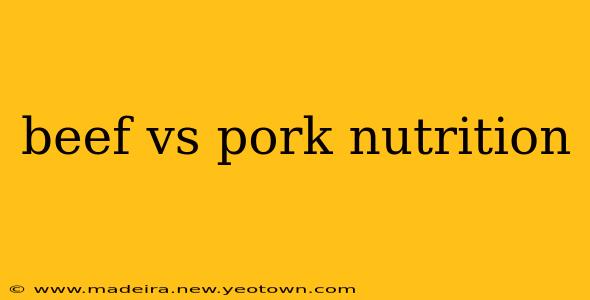The age-old debate: beef versus pork. Both are staples in kitchens worldwide, offering delicious versatility and a satisfying protein punch. But when it comes to nutrition, which one reigns supreme? Let's dive into a head-to-head comparison, exploring the nutritional profiles of these popular meats and unpacking some common questions.
Imagine this: you're planning your weekly meals, torn between a juicy steak and succulent pork chops. The decision, seemingly simple, hinges on a deeper understanding of what each meat brings to the table nutritionally. This isn't just about calories; it's about vitamins, minerals, and the impact these choices have on your overall health.
Beef: The Nutritional Powerhouse
Beef, especially lean cuts, packs a serious nutritional wallop. Think of a perfectly seared sirloin, its rich flavor hinting at the goodness within. It's a fantastic source of:
- High-quality protein: Essential for building and repairing tissues, crucial for muscle growth and overall health.
- Iron: Crucial for carrying oxygen throughout the body, preventing anemia. Beef provides heme iron, a form easily absorbed by the body.
- Zinc: Supports immune function, wound healing, and cell growth.
- B vitamins: Essential for energy production and various metabolic processes. Riboflavin (B2), niacin (B3), and vitamin B12 are particularly abundant.
- Selenium: An antioxidant that protects cells from damage.
However, it's important to note that the nutritional content can vary significantly depending on the cut of beef. Leaner cuts like sirloin, tenderloin, and top round are generally lower in fat and calories compared to richer cuts like ribeye or prime rib.
Pork: The Versatile Contender
Pork, often unfairly overshadowed by its beef counterpart, offers a compelling nutritional profile of its own. Picture a flavorful pork tenderloin, lean and versatile enough for countless recipes. It provides:
- Excellent source of protein: Similar to beef, pork delivers high-quality protein, essential for building and maintaining healthy tissues.
- Thiamin (B1): Important for carbohydrate metabolism and nerve function. Pork is an excellent source of this vital B vitamin.
- Niacin (B3): Contributes to energy metabolism and helps maintain healthy skin.
- Phosphorus: Essential for bone health and energy production.
- Vitamin B6: Plays a role in brain development and immune function.
Like beef, the nutritional value of pork varies depending on the cut. Lean cuts such as tenderloin and loin chops are preferable to fattier cuts like ribs or belly.
What about Fat Content?
This is a critical point of differentiation. While both beef and pork contain fat, the type and amount differ. Beef tends to be higher in saturated fat, which, in excess, can raise cholesterol levels. Pork, on the other hand, boasts a more balanced fat profile, with a lower proportion of saturated fat compared to some beef cuts. However, the preparation method significantly impacts the final fat content. Grilling or broiling, for instance, helps reduce fat compared to frying.
Which is Healthier? Beef or Pork?
There isn't a clear-cut winner. The "healthier" choice depends on several factors including the specific cut, preparation method, and individual dietary needs. Choosing lean cuts of both beef and pork, and preparing them in healthy ways, are key to maximizing nutritional benefits and minimizing potential drawbacks.
How Much Beef and Pork Should I Eat?
Dietary guidelines vary, but generally recommend moderation in red meat consumption. Balancing your protein intake with other sources like poultry, fish, beans, and lentils is crucial for a well-rounded diet. Consult a healthcare professional or registered dietitian for personalized advice tailored to your specific needs and health goals.
Are there specific cuts of beef and pork that are better nutritional choices?
Yes, lean cuts are generally preferred. For beef, look for sirloin, tenderloin, and top round. For pork, opt for tenderloin and loin chops. These leaner cuts are lower in saturated fat and calories while still offering a substantial amount of protein and essential nutrients.
Can I still enjoy beef and pork while watching my cholesterol?
Absolutely! By selecting lean cuts and employing healthy cooking methods like grilling or baking, you can significantly reduce the fat content, including saturated fat. Moderation is key, and incorporating plenty of fiber-rich foods and regular exercise can help maintain healthy cholesterol levels.
What are some healthy ways to prepare beef and pork?
Grilling, baking, broiling, and stir-frying are all excellent choices. Marinating the meat before cooking can not only enhance flavor but also help tenderize it. Avoid deep frying, which significantly increases the fat content.
Ultimately, both beef and pork can be part of a healthy, balanced diet. By making informed choices about the cuts you select and how you prepare them, you can enjoy the delicious flavors while maximizing nutritional benefits and minimizing any potential health risks. Remember, variety is key to a successful and enjoyable diet!

